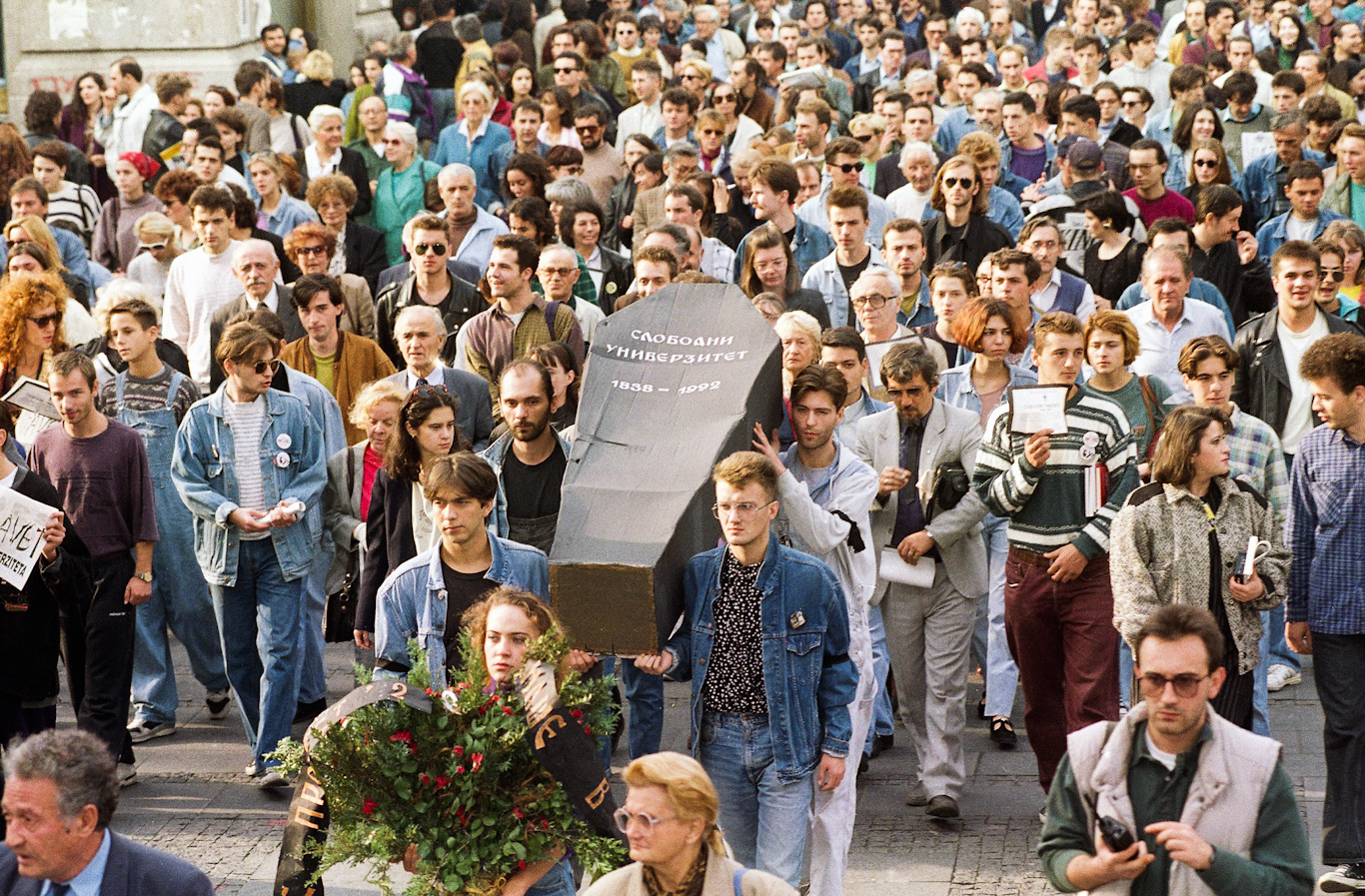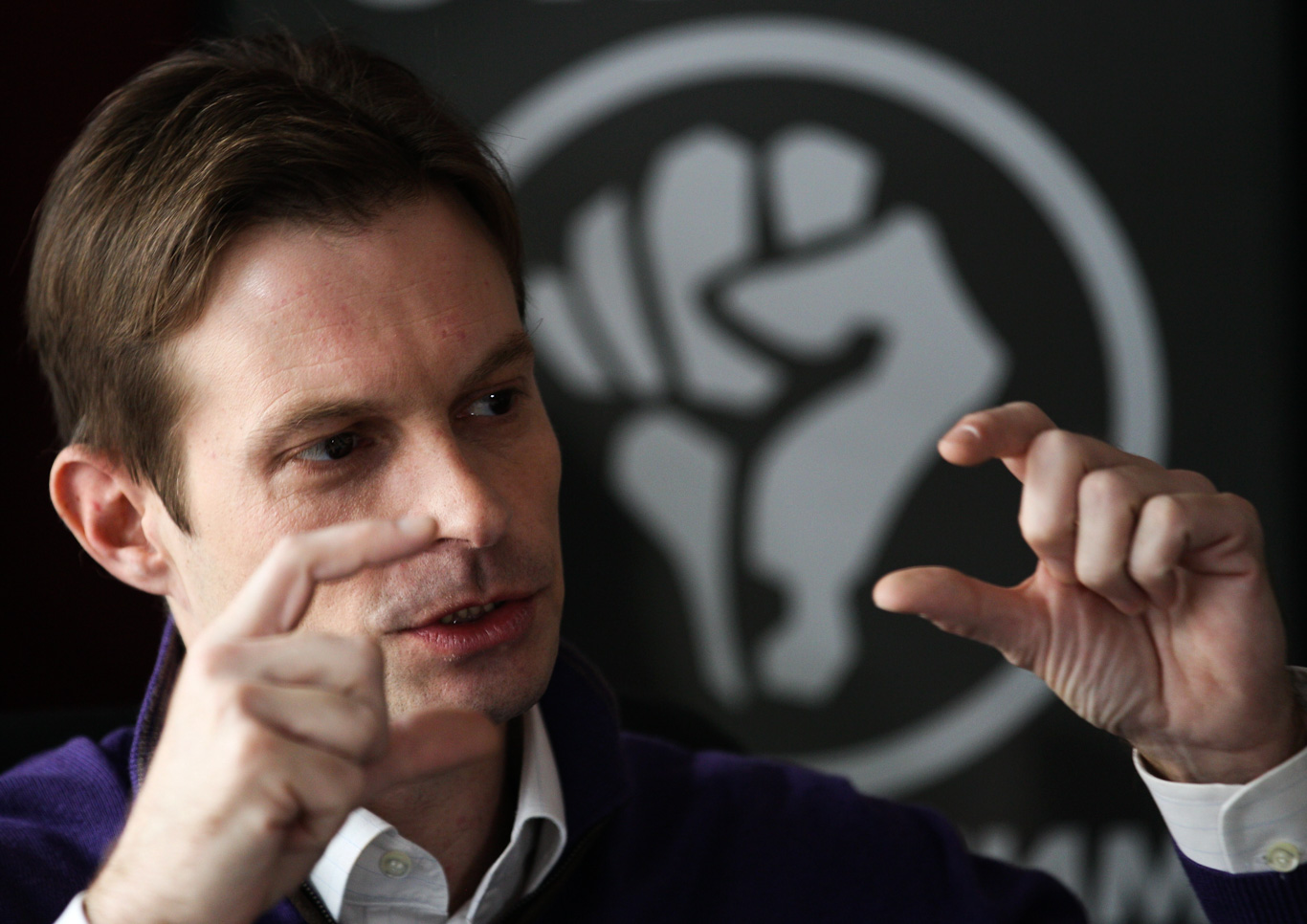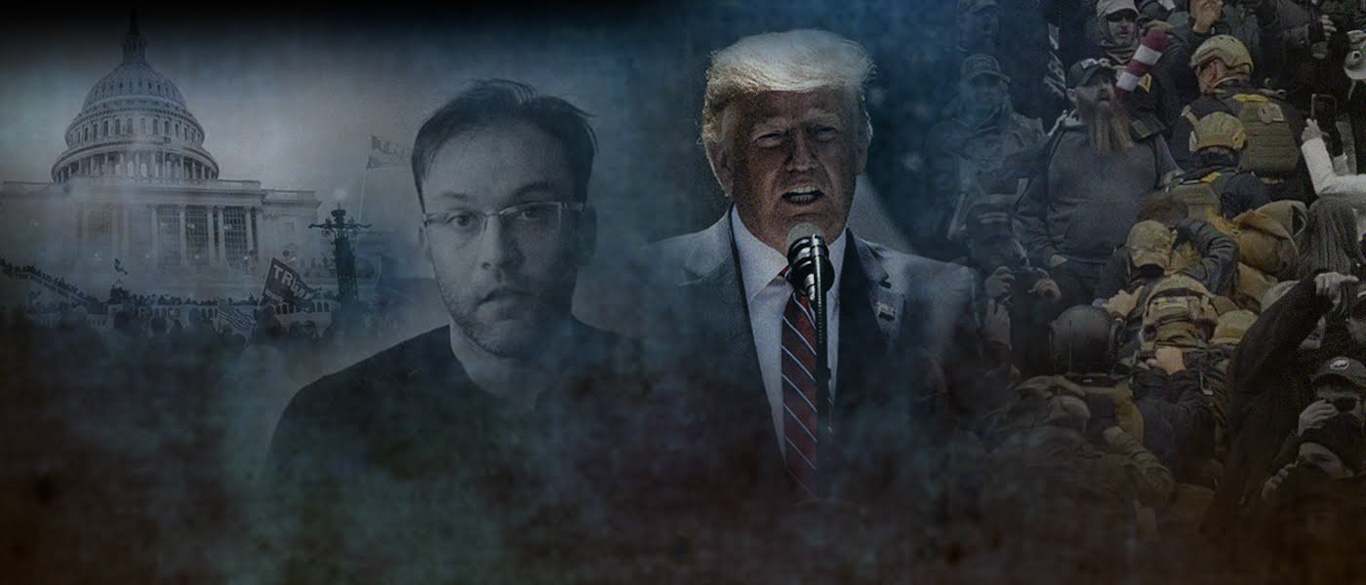As the Capitol insurrection on January 6 descended into a frenzy of mob violence, a far-right paramilitary group known as the Oath Keepers marched through the sea of rioters and protesters, up the east steps of the Capitol building and into the rotunda. Video from that day shows the Oath Keepers marching in a military formation known as “Ranger File”, described by the Associated Press as ‘standard operating procedure for a combat team that is “stacking up” to breach a building – instantly recognizable to any U.S. soldier or Marine who served in Iraq and Afghanistan.’
On November 10, 2020, nearly two months before the insurrection that had sought to prevent the transfer of power to then-president-elect Joe Biden, the Oath Keepers distributed a propaganda letter titled “March on DC, Stop the Steal, Defend the President, & Defeat the Deep State.” It was signed by Oath Keepers founder Stewart Rhodes, a former aide to Libertarian member of congress Ron Paul.
The letter urged supporters to “directly back-up and defend President Trump as he fights against the ongoing coup that is attempting to steal the election” and boasted that the “Oath Keepers is sending some of our most experienced LEO and military combat veterans into D.C.”
Nearby, the letter stated, “Oath Keepers will also have some of our most skilled special warfare veterans standing by armed, just outside D.C…. as an emergency QRF in the event of a worst case scenario in D.C. (such as a’“Benghazi’ style assault on the White House by communist terrorists, in conjunction with stand-down orders by traitor generals).”
Rhodes’ letter asserted that by marching on the capitol to prevent Joe Biden from being officially declared the winner of the 2020 presidential election, the Oath Keepers would actually be protecting American democracy. “Our men will be standing by, awaiting the President’s orders to call us up as the militia. By President Trump refusing to concede, he is stopping a coup rather than engaging in one,” it read.

The Oath Keepers’ strategy was influenced by experience from an unlikely place. Under a section labeled “WHAT THE PEOPLE MUST DO,” a self-described “patriot from Serbia, who also loves America” called on the insurrectionists to carry out a violent coup d’etat modeled after the U.S.-orchestrated color revolution that deposed socialist president of Serbia Slobodan Milošević in 2000.
MintPress identified the “patriot from Serbia,” who also appears in a video on the Oath Keepers website, as Aleksandar Savic, an accomplished young scientist with multiple degrees from the University of Belgrade.
Savic maintains a Bitchute channel with the username “PhDLife” where he has uploaded 15 videos between October 2020 and January 24. They reveal a deep admiration for the United States and grave concern about a socialist takeover of the country.
“Not a single country in Eastern Europe was able to get rid of [socialism], not even after decades, not even after two generations,” he warns in one video. “The world you know will cease to exist. You are never going to claim it again.”
In an emailed correspondence with MintPress, Savic said he reached out to the Oath Keepers after stumbling onto their Youtube video.“The name of the organization sounded cool. Their program and goals were traditionalists and I just asked if I can be useful,” he wrote. (There is a far-right political party in Serbia called Zavetnici (Oath Keepers) but they deny having ties to the Oath Keepers in the United States. There is no online evidence that any such links exist.)
Savic’s Linkedin profile is adorned with an American flag that reads “Patriot in hearth [sic] who never stepped foot on American soil, looking for a job.” He adds, “For HR: Very high level of conscientiousness and openness. High extroversion, low neuroticism, and low agreeableness, but I can manage it. God bless America.” One post describes the COVID19 pandemic as a “scam used to hurt the economy” and says “masks are the most stupid thing ever invented.”

The most-watched videos on his Bitchute page stoke fear and offer English-language instruction based on how insurrectionists in Serbia employed a variety of tactics to fight Milošević. In them, he urges protesters and rioters in the United States to follow their blueprint to replicate their success.
In his November 2020 video “STEP BY STEP PROCEDURE, HOW WE WON WHEN MILOSEVIC STOLE OUR ELECTIONS,” Savic recounts the events of October 2000, saying that millions had assembled in the Serbian capital, overran barricades, and convinced the state’s armed forces to join them after engaging them in violent confrontations. “Police and military aligned with the people after few hours of fist-fight,” Savic says. “When they see that sea of people…they saw that they’d be fighting a lost cause.”
Savic warns that “they” – referring to the Democratic Party though never mentioning it directly – will try to steal the elections, just as, he claims, Milošević did in 2000. He also reassures viewers that they will be called “fascists,” “traitors,” and “foreign mercenaries.” Again, he says, “Milošević did that to us.”
Indeed, the Milošević government characterized the U.S.-backed opposition as such – an accusation bolstered by the fact much of it was, despite most western media portrayal, actually right-wing. Ivan Markovic, spokesman for the Yugoslav Left, or JUL, Milošević’s wife’s party, accused the opposition coalition Alliance for Change of wanting violence and compared them to 1930s Nazi death squads. Markovic also referred to liberal opposition leader and Western darling Zoran Djindjic as a fascist.
While Savic’s description of events in Serbia is partially accurate, his portrayal of the anti-Milošević opposition as a purely organic movement free of outside interference is not.
‘The most effective element of the Serbian opposition’
After a 78-day NATO war on Yugoslavia failed to achieve regime change, the U.S. and Western European governments turned to other means to overthrow the Socialist Party government in Yugoslavia led by Milošević. The election provided an opportunity for the U.S., which had spent years cultivating cadres of student protesters and forming the ideologically fractured anti-Milošević political parties under the banner of “Democratic Opposition Of Serbia,” or DOS.
“US diplomats knocked their heads together until they formed a cohesive and united coalition,” Christian Science Monitor correspondent Peter Ford wrote in a piece titled “How the Balkan strongman was toppled.”
A 2019 publication of the U.S. military’s Joint Special Operations University titled “Support to Resistance: Strategic Purpose and Effectiveness” explains the multi-faceted strategy to ensure the victory of Vojislav Kostunica, who is described as the favored “anti-communist candidate.”

The strategy included a psychological operations component known as “Ring around Serbia,” which used radio broadcasts of U.S.-government propaganda arms Worldnet, Voice of America, and Radio Free Europe/Radio Liberty’s Serbian service to “[wean] public support away from Milošević. The U.S. also ran its “MATRIX project,” which sought to weaken Milošević’s inner circle, compelling some of his closest confidantes to flee the country.
But most important, according to then-ambassador James Dobbins, was a student activist group cultivated by the United States named Otpor – what he hailed as “the most effective element of the Serbian opposition.” Otpor is Serbian for “resistance” and operated under the slogan “Gotov je” Serbian for “he is finished.
In neighboring Hungary, William Montgomery – who would go on to be named U.S. ambassador to Belgrade – had set up an office in 1998 to train Otpor opposition activists in how to bring down a government. Gene Sharp, nicknamed the “Machiavelli of nonviolence” who pioneered the field of “nonviolent revolution” dispatched retired U.S. Army Colonel Robert L. Helvey to run a weekend workshop for Otpor leaders. “In many ways, the framework that Helvey proposed to Otpor was a mirror image of the principles of strategy and process for formulating strategy taught at various U.S. military schools,” military theorist Richard H. Shultz wrote in another Joint Special Operations University book titled “Resistance Views.”
Otpor’s internal structure resembled a secretive intelligence agency more than a democratic student movement. Helvey wrote that “Otpor developed a leadership that was unknown to most of its members. The leadership never met as a group but only briefly with one another as was required.”
Ambassador James Dobbins wrote in his 2017 memoir ‘Frontlines: Fives Decades of Service on the American Frontline of Diplomacy’ that Otpor organized “increasingly massive rallies, often in the guise of rock concerts, and possessed a clear strategy to force regime change.”
While Otpor sought to portray itself as an independent movement, one member confessed that it was almost entirely bankrolled by Washington’s regime change apparatus. “‘Eighty-five percent of our funding came from the United States, ’through bodies such as the National Endowment for Democracy, the International Republican Institute and the National Democratic Institute, as well as USAID.”
One of the United States’ key tactics was to have its trainees closely monitor the fateful fall 2000 general election. “We brought one of Otpor’s young leaders to Washington, arranged meetings throughout the administration, and sent him back with enough funding to train and deploy 30,000 election monitors,” Dobbins explains. Former U.S. Army Special Forces officer and military analyst Will Irwin identifies that young leader as Otpor co-founder Srdja Popovic.
The Clinton administration calculated that by using Otpor and the “pro-democracy” opposition groups as a proxy, the toxic cloak-and-dagger image long associated with coups carried out by U.S. intelligence agencies would be avoided. “Political risk for the USG was mitigated by openly describing the support to Otpor and other opposition elements as a democracy promotion project, although it was intended from the beginning as a means to facilitate regime change,” Irwin wrote.
As the Otpor-led demonstrations went on, the Milosevic government sought to undermine the opposition by clamping down on media and communications. But according to “Resistance Views,” the U.S. and European Union had long prepared for that possibility and supplied funds slated for media technology including “copy machines, phones, postage and printing, computers, and Internet services.”
“When the regime took control of Belgrade’s largest newspapers and television and radio stations in May, Otpor was ready for that, as well. It had established its own communication and information systems and continued to communicate with the population.”

This extensive communication and information system is what prompted WIRED journalist David S. Bennahum to dub the anti-Milosevic movement the “Internet Revolution” in 1997.
“For the first time, the Net is playing a crucial role in a popular uprising against an authoritarian regime,” he gushed.
In addition to electronic communication, the U.S.-funded opposition employed traditional propaganda methods. According to Helvey, “over 60 tons of leaflets were shipped into the country and distributed within a few days prior to the election in 2000.”
Helvey’s strategy harnessed western media to reinforce and amplify the image of Serbia as a repressive dictatorship. This “increased the cost of repression to the regime by using communications tools to show the Serbian people and the world the brutality of the regime. In this respect, they were able to cause regime repression to backfire.”
‘The United States was careful to assign full credit to the Serb opposition’
The U.S.-trained election monitors were deployed to oversee the polling stations on the September 24 general election. Their presence was meant to guard against a scenario in which Milošević might declare victory. According to Helvey, they had done “extensive planning to seize power… prior to the election.” Indeed, they were adamant that Koštunica, the right-wing presidential candidate for DOS, had won the presidency in the first round with more than 50 percent of the vote. The Federal Electoral Commission disagreed and announced instead that neither Kostunica nor Milosevic had won a majority, meaning a second round was required. In response, protesters “organized and encouraged by Otpor and the political opposition” held demonstrations in cities and towns across the country to demand that Milosevic step down. Following days of nation-wide demonstrations, protesters from across the country descended on Belgrade.
According to “Resistance Views,” the Milošević government ordered police to create roadblocks to prevent the protesters from converging on the capital, “but back-channel meetings between Otpor and the DOS leaders, and their counterparts in the security forces, resulted in an agreement that the security forces would set up blockades but not enforce them.”
With the electoral results heavily contested and in an atmosphere of confusion, anti-Milošević sentiment reached a crescendo on the evening of October 5. Led by Otpor, opposition supporters seized the Federal Parliament building and broke into Radio Television Serbia (RTS) – dubbed “TV Bastille” by the protesters. The next day, Milošević conceded defeat in a televised address, congratulating Koštunica on his victory.
The fall of Milošević was coined the “Bulldozer Revolution” – a reference to the rioters’ commandeering of a bulldozer to break through police lines and inflict damage on the RTS building.
While Savic himself says he was too young to join the Otpor-led demonstrations, he is proud that he tore down pro-Milošević posters.
Meanwhile, U.S. Secretary of State Madeleine Albright sought to de-emphasize the U.S. role in overthrowing Milošević. “After Koštunica’s victory,” she wrote in her 2003 bestselling memoir ‘Madam Secretary,’ “the United States was careful to assign full credit to the Serb opposition.”
The storming of the Serbian parliament foreshadowed the insurrection at the U.S. Capitol that would take place more than 20 years later. Rioters ransacked the building and took chairs belonging to members of parliament. While the self-described “Stop the Steal” rioters smashed windows and stole lawmakers’ personal property in a failed bid to keep Trump in power, the U.S.-backed agitators set the building on fire and succeeded in mounting a coup d’etat.
In Washington, the U.S. military had blocked off the street that gives access to CNN’s building as a precautionary measure. Nonetheless, a group of rioters outside the Capitol building destroyed media equipment and set it on fire. And while western media has decried the storming of the U.S. capitol as “domestic extremism” and “terrorism,” they portrayed the U.S.-funded activists in Serbia as leaders of a “truly popular revolution” that was a moment of “hope, triumph and justice.” The Serbian color revolutionaries even appeared at an MTV Europe ceremony to receive the Free Your Mind Award.
The fundamental difference between the insurrections in Belgrade in 2000 and Washington in 2020, of course, is that the Serbian coup mongers had the power of the U.S. empire and its media apparatus behind them, while the pro-Trump mob invaded the legislature where those very congressional appropriations bills that provided tens of millions in funding for the Serbian revolutionaries were approved.
When Otpor and the opposition’s clandestine relationship with the United States was revealed to the public, it came as a shock to their base of support. “Like the entire opposition to Milosevic, Otpor took money from the U.S. government, and lied about it” Tina Rosenberg wrote in Foreign Policy magazine. “When the real story came out after Milosevic fell, many Otpor members quit, feeling betrayed.”
The kids who ran OTPOR grew up
The downfall of Milošević was the culmination of a decade of sanctions imposed by the U.S. and its allies that further destabilized a country already beset by resurgent nationalism and internal warfare, followed by a NATO bombing campaign that killed at least 500 civilians. In 2008, Samantha Power – now Joe Biden’s director of USAID – said that the bombing campaign was “partly about NATO credibility”.
Yugoslavia eventually dissolved into seven states and began transitioning to U.S.-style liberal democracy. Since then, generations of youth have emigrated, creating a crisis that threatens the region’s future.
For his part, Milošević was accused of war crimes but died in 2006 while imprisoned at the Hague.

In 2003, veteran Otpor leader Srjda Popovic went on to found the Center for Applied Nonviolent Strategies, commonly referred to by its acronym, CANVAS. The group has trained opposition activists in several dozen countries across the world including Ukraine, Georgia, Russia, Egypt, Tunisia, Venezuela, Iran, Zimbabwe, Lebanon, and China – all targets of its progenitor and funding source, the U.S. empire. Juan Guaidó, the self-declared “interim president” of Venezuela and frontman for the U.S.-orchestrated coup attempts reportedly participated in a CANVAS training session in Mexico.
The private intelligence outfit Stratfor, known as the “Shadow CIA” described CANVAS succinctly in a leaked email. After running Milošević out of power, “the kids who ran OTPOR grew up, got suits and designed CANVAS… or in other words a ‘export-a-revolution’ group that sowed the seeds for a NUMBER of color revolutions. They are still hooked into U.S. funding and basically go around the world trying to topple dictators and autocratic governments (ones that U.S. does not like ;).”
‘Yes, I am calling for violence’
Parting ways with the “applied nonviolent struggle” espoused by CANVAS, Savic repeatedly stresses that protesters in the United States must be willing to use violence to accomplish their goals. “They must feel fear. While they are counting their fake ballots, they must think about ‘are [we] going to get out of here alive’? Yes, I am calling for violence. If that is the only way, who cares? We [in Serbia] were in that situation.”
Phone calls and messages asking Savic to clarify what forms of violence he was calling for went unanswered.
Savic goes viral
Savic’s November 2020 video titled “STEP BY STEP PROCEDURE, HOW WE WON WHEN MILOSEVIC STOLE OUR ELECTIONS“ was reuploaded to a Youtube account called Mrgunsngear B Channel run by U.S. Air Force and Army veteran Mike Plouff where it has received more than 250,000 views. The popular U.S.-based channel contains hundreds of instructional videos on weapons and ammunition, analysis of protests, and even a warning from Venezuelan Olympic sport shooter Gabby Franco warning that outlawing gun ownership would be the first step towards a socialist takeover by Senator Bernie Sanders and Congresswoman Alexandria Ocasio-Cortez “that will destroy the United States if implemented.”
As Savic’s polemic into the right-wing mediasphere went viral, top Republican politicians. organizers of so-called “Stop the Steal” rallies around the country and QAnon conspiracy theorists began to disseminate the video as a warning of what failure to prevent a Biden presidency would mean for future generations.
Tracey Beanz, a well-known figure among Arizona’s conservative movement, tweeted a link to the viral Youtube video, which Arizona Republican Party Chairwoman Kelli Ward then retweeted, adding Savic’s warning.

Beanz’s Twitter account has since been suspended, apparently in the purge of accounts that Twitter alleges promoted the QAnon conspiracy theory.
During a December 20 rally at the state capitol, Ward again referenced Savic’s video during a diatribe against Biden’s electoral victory. “How many of you saw the video of the guy from Serbia saying that their elections were stolen?” she shouted. “And what did he say? If you lose now, you lose forever! We cannot lose now!”
Even after Twitter’s mass-suspension campaign, a search shows that Savic’s instructional video has been tweeted thousands of times. Among its promoters are top QAnon account CodeMonkeyZ, who had amassed 474,000 followers before being suspended in the January 8 purge. CodeMonkeyZ’s tweet drew heavy traffic, racking up more than 7,100 retweets. Nevada-based author and QAnon supporter Janie Johnson repeatedly promoted it. Former National Hockey League player and Olympian Theo Fleury’s tweet earned hundreds of retweets.
Savic’s polemic also gained views on 8kun’s QResearch forum, the top platform for QAnon conspiracy theory, and where some of the Capitol insurrection was planned and extreme violence discussed. The video also gained views on more obscure sites like We Are The News.
It is unknown how far the video’s reach went on Parler, the right-wing social media platform, which was shut down after January 6. The video also made the rounds Reddit’s popular pro-Trump forum util it was censored following the insurrection. Though the forum was reopened at the domain “The Donald.Win,” where the video continued to rack up views, it too has been permanently suspended.

Dozens of supporters of the insurrection thanked Savic in comments on the original Bitchute version. “Since President Trump called us to the capitol on January 6th your video has been spreading all around and brought me here,” reads one ominous comment. “I hope we can do something because I’ve been trying to make people see how much trouble we are in and they will not listen. There are people willing to defend our country but enemies in media and big tech are making things difficult. But we have been called to our capitol on the 6th and patriots know we must be there. Pray for us, brother.”

‘Arrest this assembly’
As a loose coalition of far-right militias, QAnon conspiracy theorists and Trump supporters materialized intent on preventing the certification of the electoral vote that would officially recognize Joe Biden’s victory, the Oath Keepers issued calls for violence.
According to FBI allegations revealed in court documents, on December 31, just one week before the coup attempt, Oath Keepers militant Thomas Caldwell remarked: “This kettle is set to boil… It begins for real Jan 5 and 6 on Washington D.C. when we mobilize in the streets. Let them try to certify some crud on capitol hill with a million or more patriots in the streets.”
Amid the riot, Jessica Watkins, another member of the paramilitary who has since been arrested, indicated on a voice messaging app that the Oath Keepers were secretly plotting their actions for January 6.
While Watkins was inside the Capitol building, unknown voices urged her to capture members of congress on the messaging app. “You are executing citizen’s arrest. Arrest this assembly; we have probable cause for acts of treason, election fraud,” one said. This is what you’ve “trained for,” another said.
“We have a good group. We have about 30-40 of us. We are sticking together and sticking to the plan.” The FBI claims as an unknown male responds, “We’ll see you soon, Jess. Airborne.”
‘A complete mess’
As the FBI arrests participants in the insurrections, its armchair spiritual leader Aleksander Savic has relocated to Texas where he claims to be writing a “dictionary” to “help the American society understand the choices they are making.” Meanwhile, he continues to upload videos to his Bitchute channel. A January 24 edition analyzes the coup’s failure and advises his followers on how they should proceed into the future.
Addressing the participants as if he were their leader, Savic laments the events at the capitol as “a complete mess,” He blames the failure on a lack of organization among the insurrectionists “because going to the protest without clear aim, without clear duration of that protest and without the logistics, it was pretty much impossible.”
While Savic lauds the individual efforts, he complains that the insurrectionists did not have a strong enough presence in the Republican party – a claim bolstered by a YouGov poll showing 45% of Republican voters disapprove of the storming of the capitol. “You lost on a tactical level last month because your party was not able to make organization,” Savic explains. “It was incredible to see all the rallies that you spontaneously organized with grassroots movements. However, you didn’t have the organization inside the party.” He disparages the events in the Capitol as insufficiently destructive, saying “People entered the capitol, which was, I don’t know, a tourist attraction I guess… I have never seen such riots, if we can call it [a] riot.”
Yet Savic ultimately traces the failure to election night itself, promoting the conspiracy theory of an election rigged against Trump. “During the election night, something strange happened. You Americans taught us how to fight for fair elections and in my country it is impossible to have poll watchers from only one party.”
Finally, Savic says that Americans must take a long-term approach to reverse what he believes is a socialist victory. “So you need to fight, speak the truth, strengthen up yourself and create the next generation of people who will return the system back.” He warns that a failure to do so will inevitably lead to the US transforming into one of the countries it has targeted for regime change. “You will experience some stuff, but hopefully you will be smart enough to not become Venezuela or Yugoslavia or Romania or any other country from Eastern Europe before you realize that you need to speak the truth.”
Though the insurrection fizzled out just hours after it started, the color revolution tactics that the U.S. government has refined around the world in the name of “democracy promotion” over the last two decades have come home. Now, they’re in the hands of any U.S. citizen with an internet connection and a desire for regime change in Washington.
Feature photo | Graphic by Antonio Cabrera for MintPress News
Dan Cohen is a journalist and filmmaker. He has produced widely distributed video reports and print dispatches from across Israel-Palestine. Dan is the Washington DC correspondent for Behind the Headline and tweets at @DanCohen3000.


